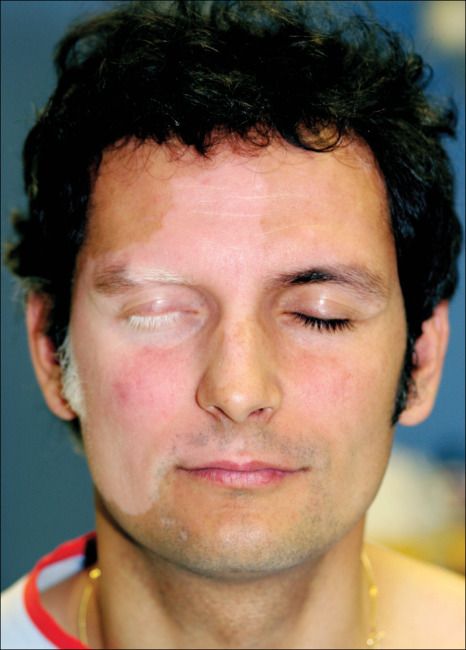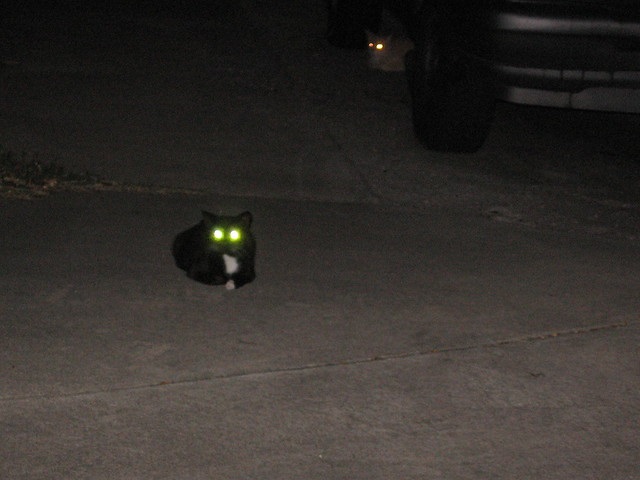cachaemites
This page is about the morphology and culture of cachaemites. If you're looking for information about the virus itself, see Contramort. If you're looking for information about the illness, see Contramort-Associated Illness.
Cachaemites, also known as drax, less commonly ceds (rhymes with heads), contramortals, or Cainnites, are people who have been infected with the C-virus. Cachaemite is a noun. The adjective form is cachaemic.
Due to their relative rarity, there are quite a few misconceptions about cachaemites, even in mixed-virus communities such as Licentia. Several high-profile cases have given them a bad rep, although unlike zeitgabberim, they are not considered apocalyptic.
Basic Information
Anatomy
Teeth damage aside, cachaemites are identical to humans in appearance except for their skin. Vitiligo and psoriasis are common in cachaemites. Less common is keratin overgrowth, in which infected develop horns.
 Vitiligo can affect both hair and skin.
Vitiligo can affect both hair and skin.

by The Lancelet
Biological Traits
In keeping with cachaemites being a response to worldwide bloodbank shortages, this virus causes the body to automatically cut vassoconstrict should there be a sudden drop in blood pressure due to a heavily bleeding wound. In a sense, the body makes its own tourniquet, with all the potentially negative drawbacks that can come with that.
Dietary Needs and Habits
Cachaemites tend to be classified by two traits, greed and need. Cachaemites with a low need tend to need only small amounts of foreign human antigens in order to trigger a satiation response, while those with a high need require higher amounts. Greed represents what happens when a cachaemite has enough to be satiated -- do they stop, or do they continue feeding? This is not a perfect system -- a low greed cachaemite might go beyond their usual amount in pursuit of a blood-high, or if they're seriously wounded -- it is just a guideline of an individual's usual behavior.
While they do drink blood, dog's blood in particular is not good for them and tends to make them ill. In addition most cachaemites do not enjoy menstrual blood, because menstruation does not just contain blood but also broken-down uterine tissue, hence making it impure.
Cachaemites with the classic strain of Contramort-Associated Illness have the ability to secrete anticoagulants, which derive from the same chemicals used in brainblanking. These aid in feeding on blood. Contrary to popular belief, the chemical in use is not draculin.
Due to their ability to cleave certain sugars, they are immune to the harmful effects of eating moldy food, including fruits. However this also makes them unable to get any benefit from penicillin, as they cleave its active site too. This was a result of the genetic engineering techniques, or more specifically, the selection techniques, to produce the virus back when it was still being grown to infected bacteria petri dishes. Newer technologies such as Rumase and Taongaso do not retain this.
Biological Cycle
Cachaemites are unique among infected in that they tend to have no environmental or temporal triggers for any of their behaviors or phenotypes beyond the time elapsed since they fed, their current emotional state, and if they are seriously wounded or not. After having no contact with foreign human antigens for about two months, their neurotransmitters fall out of balance. This typically manifests as treatment-resistant depression, bipolar disorder-like cycling, ADHD-like symptoms, and/or schizotypy. However, most cachaemites do best if they have access to foreign human antigens about once every two weeks, as they often are on Contramort for depression in the first place and foreign human antigens, when given to a cachaemite on a regular schedule, are quite effective at treating depression for reasons not fully understood.
Additional Information
Social Structure
Drax, unlike Lycan or Zeds, don't really feel a special need to constantly be around their own kind. It's difficult to say if they are more solitary than the average human or just appear that way since Zeds and Lycan are more sociable. For this reason Stoker and Jiangshi to integrate better in non-infected communities (if they can pass as non-infected) than they do mixed Zed/Ted societies such as Licentia. This isn't necessarily true of Nosfuratu or Trifected though -- the former tend to do well anywhere, and the latter seem to prefer a mixed-infection society. Keep in mind these are general preferences though, not hard and fast rules; many Drax are quite sociable and happy in Licentia.
Facial characteristics
Drax tend to have less body hair than is average for the ethnicity and sex, but they are not incapable of growing beards. Their most well-known trait is their teeth. Nerve damage resulting from early stages of infection gives most Drax an irrational obsession with filing down or removing their own teeth in order to relieve pain. After about a month, this need fades, but by then damage is usually done -- either lacking several teeth, or having several sharpened ones. Jiangshi have the ability to use Melding to replace the teeth the lost, but unless done with human teeth this tends to look a bit off.
Perception and Sensory Capabilities
Cachaemites tend to have quite good vision in the dark, a side effect of Contramort making slight changes to the eye to test how such a virus reacts to an immune privileged location. Most develop a tapetum lucidu, which technically gives them glowing eyes, but less in the sense of your favorite anime character's more powerful form and more in the sense of cursed images:
As you might imagine, cachaemites are sensitive to bright lights, especially sudden ones.
Conservation Status
Cachaemites are the rarest form of infected, even though their associated drug was more popular than the T-virus associated drug, as they lack the cool abilities of RAI and Lycan that push purposeful infections and the virus itself does not spread easily. Cachaemites are also at risk of dying from blood-borne disease, lowering their numbers further. One in four of urban cachaemites are HIV positive.
Remove these ads. Join the Worldbuilders Guild










Comments
Author's Notes
"Cachaemic" is an old medical term for poisoned blood. It isn't really in use anymore, now replaced with more specific words such as septicemia. "Cainnites" is a reference to the biblical Cain, who appears in both Supernatural and is the first vampire in the World of Darkness lore. Keratin overgrowth is a reference to the mark of Cain, which was argued by Abba Jose ben Hanan as being a horn.